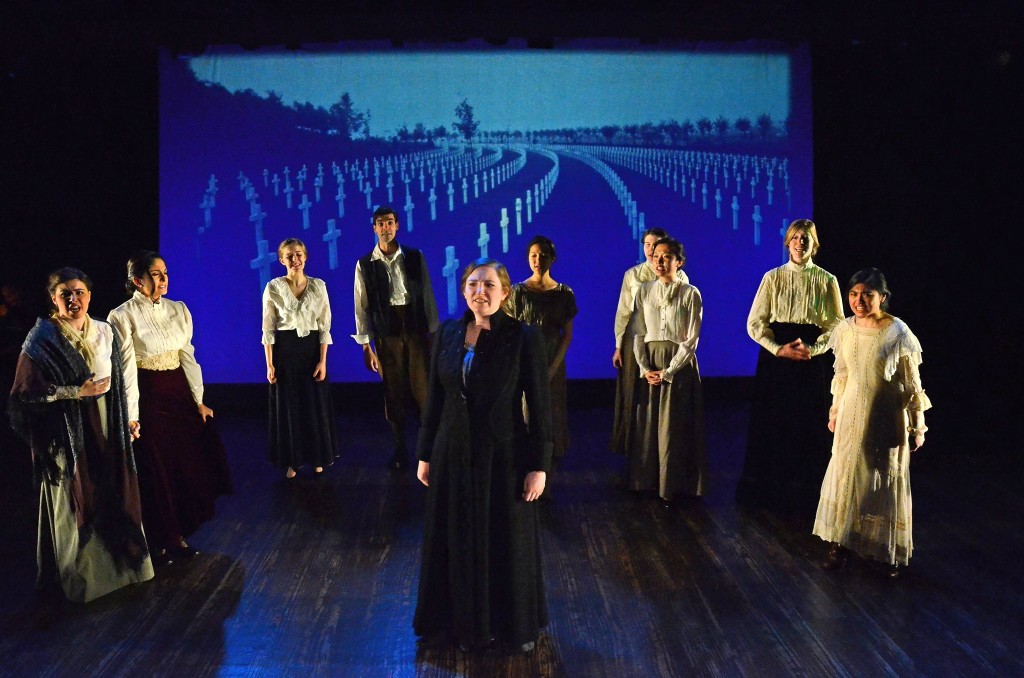
Photo image courtesy of the Facebook Page.
Presented by Wellesley College Theatre
Written by Paula Vogel
Music by Daryl Waters
Directed by Nora Hussey
November 18 – 22
Ruth Nagel Jones Theatre
Wellesly, MA
WCT on Facebook
Review by Danielle Rosvally
Christmas theatre is a very specific genre that requires a very particular mix to make effective (or even palatable). The recipe starts with good old-fashioned holiday cheer; add a dash of nostalgia, a hint of history, a generous helping of family values, and (of course) finish with a generous sprinkling of festive music. Paula Vogel’s A Civil War Christmas: An American Musical Celebration has all the necessary ingredients for the Christmas genre, but actually performing it requires a special touch. The piece’s simplistic dialogue which features such tropes as characters telling you who they are before they begin to speak (“In the West Wing of the White House, President Lincoln’s maid was cleaning the floor…. Hi, Mrs. Lincoln, how was the show tonight?”) that have the danger to edge this play towards the realm of children’s theatre cheesiness, or satirical campiness.
The Wellesley College Theatre production of this piece is serviceable. The performers are indeed very talented; singing and maneuvering their way through multitudes of characters and interwoven stories. They function as a strong ensemble, both physically, and vocally. Rachel Nagin’s singing chops were particularly noteworthy (her strong soprano could have easily edged out the other voices in Wellesley’s intimate blackbox-style space, but she knew when to bring it when the brining needed brought and when to dial it back to blend with the chorus). Ariela Nazar-Rosen shines in a delightful display of carefully crafted awkwardness as Mary Todd Lincoln and Chester Manton Saunders. Christine de Jesus Ahsan has an understated, yet powerful, capability in her performances as both Jessa and Raz. Asriel Walker is kind and capable as Mrs. Keckley and fully devoted to the small (but influential) role of Rose. John Kinsherf actually looks like Walt Whitman who, incidentally, looks like Santa Claus (though of course his performance was strong enough that this was mostly icing on the cake). Woody Gaul very nearly stole the show as the valiant horse Silver (though of course also had to balance playing both Lincoln and John Wilkes Booth, thus left with the actor predicament of how to effectively kidnap himself onstage).
Through a quirk of theatrical serendipity, the play resonates that much more deeply to an audience who has grown accustomed to looking at news and debate surrounding Syrian refugees. There can be little chance that the producers might have known their work on the American Civil War could have found such recognition amongst a contemporary audience as being so… well… timely. If for no other reason than to remind ourselves of our own history at this crucial juncture in American politics, this play is worth a look.
In dealing with the Civil War, this play also deals with the complicated and fraught issues of slavery, racism, and our country’s painful past. It can be very difficult to tackle such issues onstage in a way that doesn’t seem insensitive or (perhaps worse) insincere. This ethnically diverse cast locked into issues of race with a color-blind attitude: all members of the cast played (at one point) characters of a race not their own. This choice highlighted the senselessness of racial violence and forced an audience to see “through” every cast member to their base humanity. It was effective, particularly for an endeavor in the educational theatre.
As a fight director, I would be remiss not to make one remark about the play’s use of prop firearms. The cast was outfitted with an array of non-firing replica prop guns; a wise choice for such a project. That said, the props were not handled in a way that gave any sort of nod towards respect for the firearms. None of the actors knew trigger discipline and (worse yet) the guns were frequently pointed out at the audience for prolonged periods of time as the actors gestured dramatically with them. In such an intimate venue as Wellesley’s theatre, this essentially meant that the front row was facing down the barrel of a firearm-like prop while an actor had their finger on the trigger. While I will note that such tactics when dealing with weapons (even “toy” weapons) are bad form in any theatrical endeavor, this was particularly alarming because of the play’s setting; in a post-Columbine world, I would think that college theatre departments would become (if anything) hypersensitive about their use of firearms within the theatre.
Despite this, A Civil War Christmas will more than likely give you at least a little bit of excitement about putting up that Christmas tree. If nothing else, it will definitely make you start to question why we in modern-day America still tell stories of Victorian England in order to put ourselves in the holiday spirit. I mean, there aren’t any spooky ghosts in Vogel’s piece, but Abraham Lincoln is definitely way cooler than anyone named “Ebenezer”.
